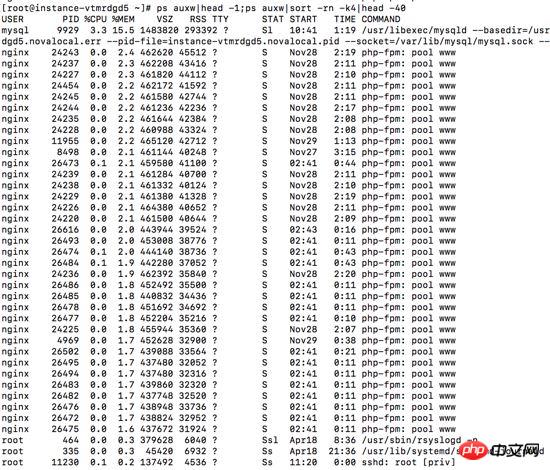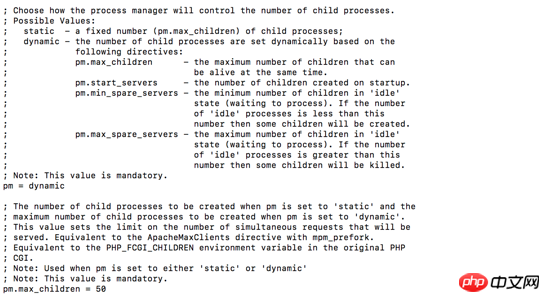 Backend Development
Backend Development
 PHP Tutorial
PHP Tutorial
 Detailed explanation of solving the problem of memory exhaustion caused by too many php-fpm processes under Linux
Detailed explanation of solving the problem of memory exhaustion caused by too many php-fpm processes under Linux
Detailed explanation of solving the problem of memory exhaustion caused by too many php-fpm processes under Linux
This article mainly introduces how to solve the problem of memory exhaustion caused by too many php-fpm processes under Linux. Friends who need it can refer to it
Recently, I found that the Linux server and database service of my personal blog often hang up. , which resulted in the need to restart before I could access it normally, which was extremely disgusting, so I decided to start solving the problem and free up my time and energy (I didn’t want to have problems frequently and then restart manually, which was laborious and time-consuming).
Analyze the problem
After discovering the problem, first use the free -m command to check the current server execution status:

You can see that my server memory is 2G, but currently there is only 70M of available memory left, and the memory usage is as high as 92%. It is very likely that the memory usage is too high. The database service hangs up.
Continue to see the details, use the top command:

Then look at the process details listed in the command output, Focus on the memory usage ratio in column 10:

It is found that the CPU usage is not high, and the CPU problem is also ruled out. In addition, you can see that the database service takes up 15.2%. Memory, when the memory usage is too high, it will crowd out the database process (the process that takes up the most memory), causing the service to hang up, so we need to check the detailed memory usage. Which processes consume so much memory?
Use command:
ps auxw|head -1;ps auxw|sort -rn -k4|head -40
View the top 40 processes that consume the most memory:

Looking at the memory usage ratio in the fourth column, we found that in addition to the mysql database service, the php-fpm service pool opened too many sub-processes, occupying more than half of the memory. The problem was found, and we started to solve the problem: setting control php- Number of fpm process pool processes.
Solve the problem
Through various search methods, I found that you can control php- by configuring the pm.max_children attribute. Number of fpm child processes. First, open the php-fpm configuration file and execute the command:
vi /etc/php-fpm.d/www.conf
Find the pm.max_children field and discover its The value is too large:

As shown in the figure, the value of pm.max_children is 50. Each process occupies 1%-2.5% of the memory, which adds up to It consumes most of the memory, so we need to reduce its value. The blogger here sets it to 25. At the same time, check the following two attributes:
pm.max_spare_servers: This value means Guarantee the maximum number of idle processes. If the idle processes are greater than this value, clean them up pm.min_spare_servers: Guarantee the minimum number of idle processes. If the idle processes are less than this value, create a new child process;
Neither of these two values can be greater than the pm.max_children value. Usually, the pm.max_spare_servers value is set to 60% of the pm.max_children value - 80%.
Finally, restart php-fpm
systemctl restart php-fpm
Check the memory usage again, the memory usage is reduced a lot:

After observing the memory usage many times, we found that after this improvement, the server memory resource consumption has been greatly alleviated.
ps: Check the number of processes started by php-fpm and the memory limit of each process
1. Use the command to check the total number of processes opened on the server. How many php-cgi processes are there
ps -fe |grep "php-fpm"|grep "pool"|wc -l
2. Check how many php-cgi processes are used to handle tcp requests
netstat -anp|grep "php-fpm"|grep "tcp"|grep "pool"|wc -l
3.In the linux nginx php environment, the memory limit of each php-fpm process
Setting method:
Edit the php-fpm.conf configuration file
php_admin_value[memory_limit] = 128M (the configuration file on my server is in /etc/php5/fpm/pool.d/www.conf This file is included in php-fpm.conf) The following numbers can be changed at will: 32M, 64M, 128M, 256M, 512M. This setting can be written according to your server memory size and your needs. After modification, Load the php-fpm service.
Summary
The above is the solution to the problem of memory exhaustion caused by too many php-fpm processes under Linux introduced by the editor. I hope it is helpful to you. If you have any questions, please leave me a message and I will reply to you in time. I would also like to thank you all for your support of the php Chinese website!
Articles you may be interested in:
Detailed analysis of examples of methods for php to implement the check-in function
Detailed explanation of data migration and data filling in Laravel
The above is the detailed content of Detailed explanation of solving the problem of memory exhaustion caused by too many php-fpm processes under Linux. For more information, please follow other related articles on the PHP Chinese website!

Hot AI Tools

Undresser.AI Undress
AI-powered app for creating realistic nude photos

AI Clothes Remover
Online AI tool for removing clothes from photos.

Undress AI Tool
Undress images for free

Clothoff.io
AI clothes remover

Video Face Swap
Swap faces in any video effortlessly with our completely free AI face swap tool!

Hot Article

Hot Tools

Notepad++7.3.1
Easy-to-use and free code editor

SublimeText3 Chinese version
Chinese version, very easy to use

Zend Studio 13.0.1
Powerful PHP integrated development environment

Dreamweaver CS6
Visual web development tools

SublimeText3 Mac version
God-level code editing software (SublimeText3)

Hot Topics
 PHP and Python: Different Paradigms Explained
Apr 18, 2025 am 12:26 AM
PHP and Python: Different Paradigms Explained
Apr 18, 2025 am 12:26 AM
PHP is mainly procedural programming, but also supports object-oriented programming (OOP); Python supports a variety of paradigms, including OOP, functional and procedural programming. PHP is suitable for web development, and Python is suitable for a variety of applications such as data analysis and machine learning.
 Why Use PHP? Advantages and Benefits Explained
Apr 16, 2025 am 12:16 AM
Why Use PHP? Advantages and Benefits Explained
Apr 16, 2025 am 12:16 AM
The core benefits of PHP include ease of learning, strong web development support, rich libraries and frameworks, high performance and scalability, cross-platform compatibility, and cost-effectiveness. 1) Easy to learn and use, suitable for beginners; 2) Good integration with web servers and supports multiple databases; 3) Have powerful frameworks such as Laravel; 4) High performance can be achieved through optimization; 5) Support multiple operating systems; 6) Open source to reduce development costs.
 Choosing Between PHP and Python: A Guide
Apr 18, 2025 am 12:24 AM
Choosing Between PHP and Python: A Guide
Apr 18, 2025 am 12:24 AM
PHP is suitable for web development and rapid prototyping, and Python is suitable for data science and machine learning. 1.PHP is used for dynamic web development, with simple syntax and suitable for rapid development. 2. Python has concise syntax, is suitable for multiple fields, and has a strong library ecosystem.
 PHP: An Introduction to the Server-Side Scripting Language
Apr 16, 2025 am 12:18 AM
PHP: An Introduction to the Server-Side Scripting Language
Apr 16, 2025 am 12:18 AM
PHP is a server-side scripting language used for dynamic web development and server-side applications. 1.PHP is an interpreted language that does not require compilation and is suitable for rapid development. 2. PHP code is embedded in HTML, making it easy to develop web pages. 3. PHP processes server-side logic, generates HTML output, and supports user interaction and data processing. 4. PHP can interact with the database, process form submission, and execute server-side tasks.
 PHP vs. Python: Use Cases and Applications
Apr 17, 2025 am 12:23 AM
PHP vs. Python: Use Cases and Applications
Apr 17, 2025 am 12:23 AM
PHP is suitable for web development and content management systems, and Python is suitable for data science, machine learning and automation scripts. 1.PHP performs well in building fast and scalable websites and applications and is commonly used in CMS such as WordPress. 2. Python has performed outstandingly in the fields of data science and machine learning, with rich libraries such as NumPy and TensorFlow.
 PHP and the Web: Exploring its Long-Term Impact
Apr 16, 2025 am 12:17 AM
PHP and the Web: Exploring its Long-Term Impact
Apr 16, 2025 am 12:17 AM
PHP has shaped the network over the past few decades and will continue to play an important role in web development. 1) PHP originated in 1994 and has become the first choice for developers due to its ease of use and seamless integration with MySQL. 2) Its core functions include generating dynamic content and integrating with the database, allowing the website to be updated in real time and displayed in personalized manner. 3) The wide application and ecosystem of PHP have driven its long-term impact, but it also faces version updates and security challenges. 4) Performance improvements in recent years, such as the release of PHP7, enable it to compete with modern languages. 5) In the future, PHP needs to deal with new challenges such as containerization and microservices, but its flexibility and active community make it adaptable.
 PHP and Python: A Deep Dive into Their History
Apr 18, 2025 am 12:25 AM
PHP and Python: A Deep Dive into Their History
Apr 18, 2025 am 12:25 AM
PHP originated in 1994 and was developed by RasmusLerdorf. It was originally used to track website visitors and gradually evolved into a server-side scripting language and was widely used in web development. Python was developed by Guidovan Rossum in the late 1980s and was first released in 1991. It emphasizes code readability and simplicity, and is suitable for scientific computing, data analysis and other fields.
 Linux Architecture: Unveiling the 5 Basic Components
Apr 20, 2025 am 12:04 AM
Linux Architecture: Unveiling the 5 Basic Components
Apr 20, 2025 am 12:04 AM
The five basic components of the Linux system are: 1. Kernel, 2. System library, 3. System utilities, 4. Graphical user interface, 5. Applications. The kernel manages hardware resources, the system library provides precompiled functions, system utilities are used for system management, the GUI provides visual interaction, and applications use these components to implement functions.





